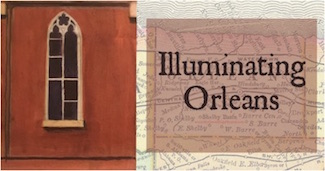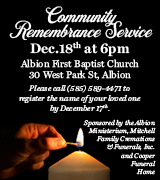Historic marker notes famous case of Charles Stielow, falsely accused of murder in Shelby
By Catherine Cooper, Orleans County Historian
“Illuminating Orleans” – Volume 5, No. 16

An innocent man was found guilty of murder and was sentenced to death by electrocution. He bade a tearful farewell to his family and was escorted to Death Row. He narrowly avoided execution several times and was exonerated after three long years.
The plot of a TV drama? Regrettably not, but an all too real nightmare endured by a Shelby family.
The reference, of course, is to the Charles F. Stielow case. He was convicted in Albion in 1915 of the murders of George Phelps and Margaret Woolcott in Shelby. An overwhelming combination of circumstances conspired against Stielow – prejudice against immigrants, unscrupulous investigators, a “confession” obtained by coercion and threats, a charlatan “expert” witness.
A thorough account of this dramatic case may be found in the book “Slaughter on a Snowy Morn” written by Colin Evans and published in 2010. It is a book that never fails to elicit a passionate response from readers: the nightmarish sequence of events described, the familiarity of the setting, and the blatant corruption all contribute to its power.
Concluding a year of exploring aspects of Orleans County history in honor of the county’s Bicentennial, members of the Medina Tuesday Club met recently to discuss this book. One overlooked aspect – the actual cost of the trial – was referenced and seemed worthy of exploration.
In New York State, criminal prosecutions are county expenses, a fact that we rarely consider or just take for granted. In 1915, Orleans County was governed by a Board of Supervisors. A record of the Board’s meetings and decisions was published annually under the title “Proceedings of the Board of Supervisors.” A primary source, these volumes form a core part of the Orleans County Dept. of History collection. The following material was sourced from the Proceedings for 1915, 1916 and 1917.
On Jan. 8, 1916, a committee appointed to tabulate the items of expense of the trial reported that the county had expended $12,649.97 at that point. The details of the expenses were listed:
- Automobile Hire: $131
- Barber: $11
- Board & Meals: $606.21
- Crier & Attendance Officers: $316.60
- Coroner: $93.05
- Coroner’s Physician: $64
- Death Watch: $18
- Detectives: $3,815.88
- Defendant’s Witnesses: $44.30
- Defendant’s Counsel: $1,379.19
- Expert Witnesses: $1,189.26
- Grand Jury: $438.70
- Grand Jury Witness: $438.70
- People’s Witnesses: $44.30
- Sheriff’s Expenses: $250
- Stenographer etc.: $1,763.40
- Trial jurors: $1,746.20
- Witness Allowance: $128
(Most likely, the Barber and Death Watch expenses occurred at Sing Sing on July 28, 1916, when Stielow came within hours of death. His head and legs were shaved in preparation for the attachment of electrodes. A Death Watch was maintained during what was expected to be his last night.)
On May 8, 1917, the Board of Supervisors approved $5,465.87 in payments to lawyers who acted as Counsel to the DA in the Stielow case: Thomas A. Kirby: $1,450, Frederic M. Thompson: $1,450, Harold A. Blake: $2,425 plus expenses of $140.87.
Additional expenses for $2,395.62 were submitted on January 18, 1917. Among these expenses were:
- George W. Newton, detective services: $648.09
- Byrne National Detective Bureau: $126.32
- Expert testimony and expenses: $582.04
- Automobile hire: $358.87
- Stenographer and typing: $264.84
- Photographer for DA, Patrick A. Grimes: $5.35
These expenses alone total $20,511.46 ($560,600 approx. in today’s cost). Additionally, on Jan.31, 1917, Gov. Whitman allocated a special appropriation of $25,000 for a reinvestigation of the case. Meanwhile, Stielow’s family, deprived of their breadwinner, were impoverished.
Charles F. Stielow was released, a free man, on May 9,1918. He received no compensation for his ordeal, nor did he seek it, he was just happy that it was over. He died at the age of 63 on Aug. 9, 1942 at his home on Church Street, Medina, having had some years to enjoy his favorite pastime – sitting on his front porch and smoking his pipe. He and his wife, Laura, are buried at the Pioneer Cemetery in Akron, NY.




































































